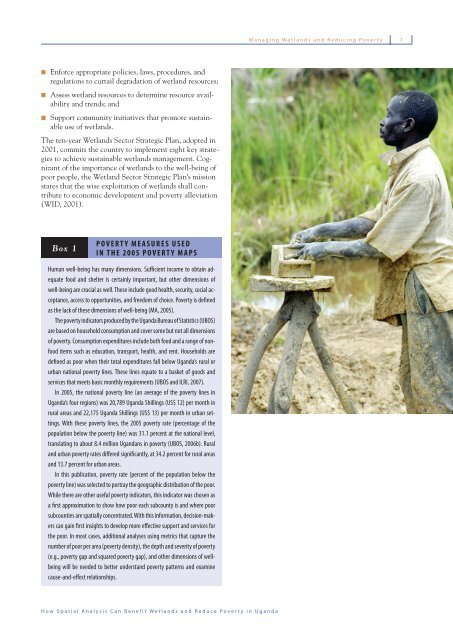Mapping a Better Future - World Resources Institute
Mapping a Better Future - World Resources Institute
Mapping a Better Future - World Resources Institute
You also want an ePaper? Increase the reach of your titles
YUMPU automatically turns print PDFs into web optimized ePapers that Google loves.
Managing Wetlands and Reducing Poverty<br />
7<br />
Enforce appropriate policies, laws, procedures, and<br />
regulations to curtail degradation of wetland resources;<br />
Assess wetland resources to determine resource availability<br />
and trends; and<br />
Support community initiatives that promote sustainable<br />
use of wetlands.<br />
The ten-year Wetlands Sector Strategic Plan, adopted in<br />
2001, commits the country to implement eight key strategies<br />
to achieve sustainable wetlands management. Cognizant<br />
of the importance of wetlands to the well-being of<br />
poor people, the Wetland Sector Strategic Plan’s mission<br />
states that the wise exploitation of wetlands shall contribute<br />
to economic development and poverty alleviation<br />
(WID, 2001).<br />
Box 1<br />
POVERTY MEASURES USED<br />
IN THE 2005 POVERTY MAPS<br />
Human well-being has many dimensions. Sufficient income to obtain adequate<br />
food and shelter is certainly important, but other dimensions of<br />
well-being are crucial as well. These include good health, security, social acceptance,<br />
access to opportunities, and freedom of choice. Poverty is defined<br />
as the lack of these dimensions of well-being (MA, 2005).<br />
The poverty indicators produced by the Uganda Bureau of Statistics (UBOS)<br />
are based on household consumption and cover some but not all dimensions<br />
of poverty. Consumption expenditures include both food and a range of nonfood<br />
items such as education, transport, health, and rent. Households are<br />
defined as poor when their total expenditures fall below Uganda’s rural or<br />
urban national poverty lines. These lines equate to a basket of goods and<br />
services that meets basic monthly requirements (UBOS and ILRI, 2007).<br />
In 2005, the national poverty line (an average of the poverty lines in<br />
Uganda’s four regions) was 20,789 Uganda Shillings (US$ 12) per month in<br />
rural areas and 22,175 Uganda Shillings (US$ 13) per month in urban settings.<br />
With these poverty lines, the 2005 poverty rate (percentage of the<br />
population below the poverty line) was 31.1 percent at the national level,<br />
translating to about 8.4 million Ugandans in poverty (UBOS, 2006b). Rural<br />
and urban poverty rates differed significantly, at 34.2 percent for rural areas<br />
and 13.7 percent for urban areas.<br />
In this publication, poverty rate (percent of the population below the<br />
poverty line) was selected to portray the geographic distribution of the poor.<br />
While there are other useful poverty indicators, this indicator was chosen as<br />
a first approximation to show how poor each subcounty is and where poor<br />
subcounties are spatially concentrated. With this information, decision-makers<br />
can gain first insights to develop more effective support and services for<br />
the poor. In most cases, additional analyses using metrics that capture the<br />
number of poor per area (poverty density), the depth and severity of poverty<br />
(e.g., poverty gap and squared poverty gap), and other dimensions of wellbeing<br />
will be needed to better understand poverty patterns and examine<br />
cause-and-effect relationships.<br />
How Spatial Analysis Can Benefit Wetlands and Reduce Poverty in Uganda

















